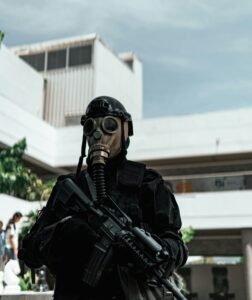Although most countries have official intelligence agencies such as the CNI in Spain or the CIA in the U.S., there are also secret or little-recognized divisions that operate outside the general public domain. Their missions include covert operations, counterterrorism, cyber espionage, political surveillance and missions abroad.
Below, we explore some little-known examples of hidden or officially unrecognized structures in various countries.
🇪🇸 Spain
🔒 Undercover CNI and Army Units
- Although the National Intelligence Center (CNI) is the best known public agency, within the CNI there are top secret units dedicated to:
- Interventions outside the country.
- Counterintelligence at the political level.
- Special operations in collaboration with NATO or CIA forces.
- The Army’s Special Operations Group (GOE) also performs military intelligence tasks, many of them highly classified.
- In addition, there are rumors of the existence of parallel units, closer to the political power, with internal oversight capacity without direct parliamentary supervision.
🇮🇹 Italy
🕵️♂️ “Deviant services” and the shadow of Gladio
- Italy has historically been the scene of covert operations, especially during the Cold War. It has been documented the existence of:
- Parallel organizations within SISMI (today AISI/AISI), dedicated to obscure tasks during the “Lead Years”.
- The Gladio network, a “stay-behind” structure created by NATO, operated on Italian territory for decades without public knowledge, and was linked to terrorist acts to stop the communist advance.
- Today, there are still very discrete internal structures, such as cells of the Direzione Operativa Centrale, focused on:
- Anti-mafia.
- Political infiltration.
- Psychological and disinformation operations.
🇲🇽 Mexico
🔍 Parallel Army Intelligence and Political Espionage
- Mexico has the CISEN (Center for Investigation and National Security), now transformed into the National Intelligence Center (CNI). But there are much more opaque structures:
- Secret sections within SEDENA (Army), focused on military intelligence, control of insurgent groups and political espionage.
- The so-called “Secret Military Intelligence Area” operates independently of the new CNI.
- Mass surveillance systems (such as the use of Pegasus) against journalists and opponents have also been documented, often operated outside the legal framework and from parallel centers.
🇨🇴 Colombia
💣 Clandestine intelligence groups linked to the internal conflict
- In addition to the well-known DAS (now defunct) and the capabilities of the DNI (National Intelligence Directorate), Colombia has been the scene of numerous unofficial structures during its internal war.
- Clandestine units within the Army or National Police have been responsible for:
- Illegal interceptions.
- Infiltration of social movements.
- Extrajudicial follow-ups.
- There are also groups known as “tactical intelligence networks”, active in conflict zones, often operating outside any legal framework, with the alleged complicity of political or military sectors.
🇲🇦 Morocco
👁️ Secret services with little transparency and strong control of power
- The main agency is the DGST (Dirección General de Supervisión del Territorio), but there are also entities that are not very visible:
- The DGED (Directorate General of Studies and Documentation), focused on foreign operations, is considered one of the most opaque agencies in North Africa.
- Morocco has been accused in multiple international reports of:
- Spying on journalists, activists and opponents both inside and outside the country.
- Using spying software such as Pegasus for tasks outside of judicial control.
- It is rumored that there are secret cells linked directly to the royal palace, with no accountability to parliament or the judiciary.
🇺🇸 United States
- NSA (National Security Agency): Although well known, its operations were highly secretive until leaks like Snowden’s. It specializes in global electronic espionage.
- JSOC (Joint Special Operations Command): Pentagon’s covert operations corps. Executes anti-terrorist missions, captures, targeted assassinations, etc. Very little is known about its actual movements.
- CIA Special Activities Center (SAC): Paramilitary and black operations unit within the CIA. Operates off any official radar.
🇷🇺 Russia
- GRU (Main Intelligence Directorate): Russian military intelligence. Although sometimes mentioned, its actual operations remain secret. Political assassinations, operations in Ukraine, hacks, etc. are attributed to it.
- Unit 29155: Specialized in covert operations, such as poisonings, sabotage or political destabilization. It only became known after journalistic investigations.
🇨🇳 China
- PLA (People’s Liberation Army) cyber units: They conduct global cyber espionage. Some are known (such as “Unit 61398”) from leaks, but their full structures remain hidden.
- United Front Work Department: Operates abroad to influence pro-China universities, companies and governments. Goes unnoticed as a “cultural agency”.
🇮🇱 Israel
- Aman: Israeli military intelligence. It is not as mediatic as the Mossad, but it is even more powerful in covert operations and tactical gathering.
- Shin Bet (Shabak): Internal security agency, but with secret units operating in occupied territories and carrying out covert operations.
🇫🇷 France
- DGSI: Homeland Security, little media, operates in counterterrorism and counterespionage. Some of its special divisions are classified.
🇰🇵 North Korea
- RGB (Reconnaissance General Bureau): It is the heart of North Korean espionage, responsible for kidnappings, cyberattacks and sabotage. It is not officially recognized in many public reports.
🧩 Conclusion.
Although many intelligence agencies are publicly acknowledged, the real espionage machinery moves at hidden, parallel levels and sometimes outside democratic control. These secret agencies or clandestine divisions play a silent role in:
- Citizen surveillance.
- Political control.
- Covert operations abroad.
Their existence is rarely confirmed, but their trail is present in leaks, scandals or actions that shake the political landscape of their countries.


